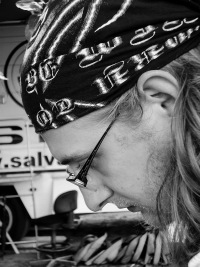очень советую эту книгу. не must–read для всех, конечно, но написано интересно и очень хороший перевод.
ключевые слова: живопись, философия, дао. по сути — сравнительный анализ европейской и китайской живописи [и философии].
издательство AdMarginem совместно с Гаражом (поэтому приятнейшая версточка и обложка), пер. А.Шестаков, ссылка под картинкой
при этом почти никакого пафоса по поводу дао.
кусочек:
«Соотнося вещи с их отсутствием или даже изображая их лишь намеком, индексально, так что они кажутся «присутствующими–отсутствующими», художник практически порывает с тягостным реализмом объекта; придавая присутствию — простым прерыванием контура — уклончивый характер, он приостанавливает и даже сдерживает по отношению к нему возможность всякого опредмечивающего сопряжения. Примем пока такую, еще условную и ограниченную отрицанием, формулировку — настолько трудноуловимым при первом контакте кажется то, что на более глубоком уровне приоткрывает нам китайский пейзаж. Трудно выразить это нечто в западных терминах, отказавшись от чистой законодательствующей внешности науки и не впав сразу же в несостоятельность субъективирующего рассуждения — ведь это рассуждение в данном случае строится не из веществ и энергии мира: колеблющееся между психологизмом и мистикой, оно остается единственным возможным коррелятором утвержденного статуса объекта при том, что отношение, поддерживаемое с этим последним, уже не сводится к восприятию, к «инспекции» духа и к познанию. Но как одного, так и другого избегает китайская мысль, и это кажется мне в ней самым ценным, самым плодотворным. Или, по правде говоря, не столько в ней, сколько в этом ее возвратном действии — в том, что она низлагает одновременно и объект, и субъект, тем самым заставляя нас вслушаться в свой язык, чтобы изжить и в нем эти противоположности».
ключевые слова: живопись, философия, дао. по сути — сравнительный анализ европейской и китайской живописи [и философии].
издательство AdMarginem совместно с Гаражом (поэтому приятнейшая версточка и обложка), пер. А.Шестаков, ссылка под картинкой
при этом почти никакого пафоса по поводу дао.
кусочек:
«Соотнося вещи с их отсутствием или даже изображая их лишь намеком, индексально, так что они кажутся «присутствующими–отсутствующими», художник практически порывает с тягостным реализмом объекта; придавая присутствию — простым прерыванием контура — уклончивый характер, он приостанавливает и даже сдерживает по отношению к нему возможность всякого опредмечивающего сопряжения. Примем пока такую, еще условную и ограниченную отрицанием, формулировку — настолько трудноуловимым при первом контакте кажется то, что на более глубоком уровне приоткрывает нам китайский пейзаж. Трудно выразить это нечто в западных терминах, отказавшись от чистой законодательствующей внешности науки и не впав сразу же в несостоятельность субъективирующего рассуждения — ведь это рассуждение в данном случае строится не из веществ и энергии мира: колеблющееся между психологизмом и мистикой, оно остается единственным возможным коррелятором утвержденного статуса объекта при том, что отношение, поддерживаемое с этим последним, уже не сводится к восприятию, к «инспекции» духа и к познанию. Но как одного, так и другого избегает китайская мысль, и это кажется мне в ней самым ценным, самым плодотворным. Или, по правде говоря, не столько в ней, сколько в этом ее возвратном действии — в том, что она низлагает одновременно и объект, и субъект, тем самым заставляя нас вслушаться в свой язык, чтобы изжить и в нем эти противоположности».
I highly recommend this book. not a must-read for everyone, of course, but it is written in an interesting and very good translation.
key words: painting, philosophy, tao. in fact - a comparative analysis of European and Chinese painting [and philosophy].
publishing house AdMarginem together with Garage (therefore, the most pleasant layout and cover), trans. A. Shestakov, link under the picture
there is almost no pathos about the Tao.
a piece:
“By correlating things with their absence, or even depicting them only in hint, indexically, so that they seem to be“ present-absent, ”the artist practically breaks with the painful realism of the object; giving the presence - by a simple interruption of the contour - an evasive character, it suspends and even restrains in relation to it the possibility of any objectifying conjugation. Let us accept for the time being such a formulation, still conditional and limited by negation - it seems so elusive at the first contact that what the Chinese landscape reveals to us at a deeper level. It is difficult to express this something in Western terms, abandoning the pure legislative appearance of science and without immediately falling into the inconsistency of subjective reasoning - after all, this reasoning in this case is not built from the substances and energy of the world: oscillating between psychologism and mysticism, it remains the only possible correlator of the affirmed the status of an object despite the fact that the attitude maintained with this latter is no longer reduced to perception, to the "inspection" of the spirit and to cognition. But Chinese thought avoids both one and the other, and this seems to me to be the most valuable, the most fruitful in it. Or, to tell the truth, not so much in her as in this her return action - in the fact that she deposes both the object and the subject, thereby forcing us to listen to our language in order to get rid of these opposites in it. "
key words: painting, philosophy, tao. in fact - a comparative analysis of European and Chinese painting [and philosophy].
publishing house AdMarginem together with Garage (therefore, the most pleasant layout and cover), trans. A. Shestakov, link under the picture
there is almost no pathos about the Tao.
a piece:
“By correlating things with their absence, or even depicting them only in hint, indexically, so that they seem to be“ present-absent, ”the artist practically breaks with the painful realism of the object; giving the presence - by a simple interruption of the contour - an evasive character, it suspends and even restrains in relation to it the possibility of any objectifying conjugation. Let us accept for the time being such a formulation, still conditional and limited by negation - it seems so elusive at the first contact that what the Chinese landscape reveals to us at a deeper level. It is difficult to express this something in Western terms, abandoning the pure legislative appearance of science and without immediately falling into the inconsistency of subjective reasoning - after all, this reasoning in this case is not built from the substances and energy of the world: oscillating between psychologism and mysticism, it remains the only possible correlator of the affirmed the status of an object despite the fact that the attitude maintained with this latter is no longer reduced to perception, to the "inspection" of the spirit and to cognition. But Chinese thought avoids both one and the other, and this seems to me to be the most valuable, the most fruitful in it. Or, to tell the truth, not so much in her as in this her return action - in the fact that she deposes both the object and the subject, thereby forcing us to listen to our language in order to get rid of these opposites in it. "

У записи 10 лайков,
0 репостов.
0 репостов.
Эту запись оставил(а) на своей стене Татьяна Фоминова





























